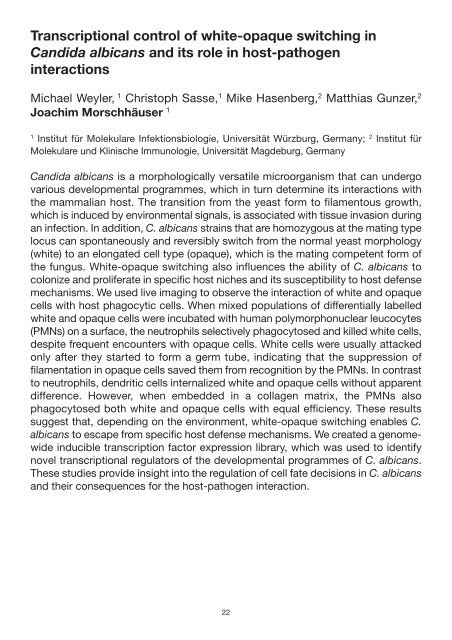Candida Infection Biology – fungal armoury, battlefields ... - FINSysB
Candida Infection Biology – fungal armoury, battlefields ... - FINSysB
Candida Infection Biology – fungal armoury, battlefields ... - FINSysB
Create successful ePaper yourself
Turn your PDF publications into a flip-book with our unique Google optimized e-Paper software.
Transcriptional control of white-opaque switching in<br />
<strong>Candida</strong> albicans and its role in host-pathogen<br />
interactions<br />
Michael Weyler, 1 Christoph Sasse, 1 Mike Hasenberg, 2 Matthias Gunzer, 2<br />
Joachim Morschhäuser 1<br />
1 Institut für Molekulare Infektionsbiologie, Universität Würzburg, Germany; 2 Institut für<br />
Molekulare und Klinische Immunologie, Universität Magdeburg, Germany<br />
<strong>Candida</strong> albicans is a morphologically versatile microorganism that can undergo<br />
various developmental programmes, which in turn determine its interactions with<br />
the mammalian host. The transition from the yeast form to filamentous growth,<br />
which is induced by environmental signals, is associated with tissue invasion during<br />
an infection. In addition, C. albicans strains that are homozygous at the mating type<br />
locus can spontaneously and reversibly switch from the normal yeast morphology<br />
(white) to an elongated cell type (opaque), which is the mating competent form of<br />
the fungus. White-opaque switching also influences the ability of C. albicans to<br />
colonize and proliferate in specific host niches and its susceptibility to host defense<br />
mechanisms. We used live imaging to observe the interaction of white and opaque<br />
cells with host phagocytic cells. When mixed populations of differentially labelled<br />
white and opaque cells were incubated with human polymorphonuclear leucocytes<br />
(PMNs) on a surface, the neutrophils selectively phagocytosed and killed white cells,<br />
despite frequent encounters with opaque cells. White cells were usually attacked<br />
only after they started to form a germ tube, indicating that the suppression of<br />
filamentation in opaque cells saved them from recognition by the PMNs. In contrast<br />
to neutrophils, dendritic cells internalized white and opaque cells without apparent<br />
difference. However, when embedded in a collagen matrix, the PMNs also<br />
phagocytosed both white and opaque cells with equal efficiency. These results<br />
suggest that, depending on the environment, white-opaque switching enables C.<br />
albicans to escape from specific host defense mechanisms. We created a genomewide<br />
inducible transcription factor expression library, which was used to identify<br />
novel transcriptional regulators of the developmental programmes of C. albicans.<br />
These studies provide insight into the regulation of cell fate decisions in C. albicans<br />
and their consequences for the host-pathogen interaction.<br />
22


